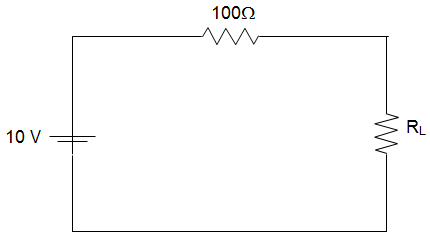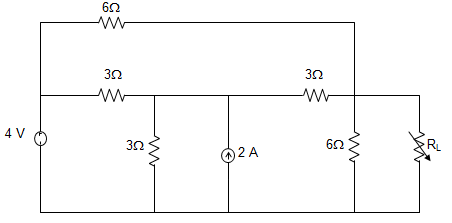This set of Network Theory Multiple Choice Questions & Answers (MCQs) focuses on “Advanced Problems on Network Theorems – 1”.
1. The temperature coefficient of a metal as the temperature increases will ____________
a) Decreases
b) Increases
c) Remains unchanged
d) Increases and remains same
View Answer
Explanation: We know that the temperature coefficient is,
Given by, α = \(\frac{α_0}{1 + α_0 t}\)
Since temperature is present at the denominator, so with increase in temperature t, the denominator increases and hence the fraction decreases.
So, temperature coefficient decreases.
2. Given a wire of resistance R Ω. The resistance of a wire of the same material and same weight and double the diameter is ___________
a) 0.5 R
b) 0.25 R
c) 0.125 R
d) 0.0625 R
View Answer
Explanation: Since diameter is double, area of cross-section is four times and length is one-fourth.
It can be verified by the following equation,
R2 = \(\frac{\frac{ρl}{4}}{4A}\)
= \(\frac{ρl}{16 A} = \frac{R}{16}\).
3. The star equivalent resistance of 3 resistors having each resistance = 5 Ω is ____________
a) 1.5 Ω
b) 1.67 Ω
c) 3 Ω
d) 4.5 Ω
View Answer
Explanation: We know that for star connection, REQ = \(\frac{R X R}{R+R+R}\)
Given R = 5 Ω
So, REQ = \(\frac{5 X 5}{5+5+5}\)
= \(\frac{25}{15}\) = 1.67 Ω.
4. The charge associated with a bulb rated as 20 W, 200 V and used for 10 minutes is ____________
a) 36 C
b) 60 C
c) 72 C
d) 50 C
View Answer
Explanation: Charge Q= It
Given I = \(\frac{20}{200}\) = 0.1 A, t = 10 X 60 sec = 600 sec
So, Q = 0.1 X 600 = 60 C.
5. For a series RL circuit having L = 5 H, current = 1 A (at an instant). The energy stored in magnetic field is ___________
a) 3.6 J
b) 2.5 J
c) 1.5 J
d) 3 J
View Answer
Explanation: We know that, Energy, E = 0.5 LI2
Or, E = 0.5 X 5 X 12 = 2.5 J.
6. For a practical voltage source, which of the following is correct?
a) Cannot be less than source voltage
b) Cannot be higher than source voltage
c) Is always less than source voltage
d) Is always equal to source voltage
View Answer
Explanation: A practical voltage source has some resistance. Because of this resistance, some amount of voltage drop occurs across this resistance. Hence, the terminal voltage cannot be higher than source voltage. However, if current is zero, then terminal voltage and source voltage are equal.
7. Consider an electric motor having resistance of 10 Ω, 20 Ω and 30 Ω respectively. The percentage of energy dissipated by 10 Ω earthing plate is ____________
a) More than 50% of total energy
b) Less than 50% of total energy
c) Depends on the materials of the three plates
d) May be more or less than 50% of total energy
View Answer
Explanation: The parallel combination of 30 Ω and 20 Ω is 12 Ω. Since 12 Ω and 10 Ω are in parallel, the 10 ohm plate draws more than 50% current and dissipates more than 50% energy.
8. Consider a resistive network circuit, having 3 sources of 18 W, 50 W and 98 W respectively and a resistance R. When all source act together the maximum and minimum power is ____________
a) 98 W, 18 W
b) 166 W, 18 W
c) 450 W, 2 W
d) 166 W, 2 W
View Answer
Explanation: Let us suppose R = 1 Ω
Then, I1 = 32 A, I2 = 52 A and I3 = 72 A
Or, (I1 + I2 + I3)2 R = (152)2 R = 450 Ω.
9. A current waveform is of the shape of a right angled triangle with period of t = 1 sec. Given a resistance R = 1 Ω. The average power is __________
a) 1 W
b) 0.5 W
c) 0.333 W
d) 0.111 W
View Answer
Explanation: We know that RMS current is,
I = 1 \( \int_0^1 (1t)^2 \,dt\)
= \( \int_0^1 t^2 \,dt\)
= \(\frac{1}{3}\) A
Now, power P = I2R
= \(\frac{1}{9}\) X 1
= 0.111 W.
10. Given two voltages, V1 = sin (ωt + 60°) and V2 = cos (ωt). Which of the following is correct?
a) V1 is leading V2 by 15°
b) V1 is leading V2 by 30°
c) V2 is leading V1 by 60°
d) V2 is leading V1 by 30°
View Answer
Explanation: Given that, V1 = sin (ωt + 30°) and V2 = cos (ωt)
Now, V2 can be written as,
V2 = sin (ωt + 90°).
Hence, V2 is leading V1 by (90 – 30) = 60°.
11. Given two mutually coupled coils have a total inductance of 1500 mH, the self-inductance of each coils if the coefficient of coupling is 0.2 is ____________
a) 325 mH
b) 255 mH
c) 625 mH
d) 550 mH
View Answer
Explanation: We know that, M = k\(\sqrt{L_1 L_2}\)
Given that, LEQ = 1500 mH and k = 0.2
Again, total inductance = L1 + L2 + 2M
Or, 2L + 2kL = 1500 mH
Or, L (2 + 2 X 0.2) = 1500
Or, L = 625 mH.
12. For a series RL circuit, the impedance Z = 10 Ω at a frequency of 50 Hz. At 100 Hz the impedance is ___________
a) 10 Ω
b) 20 Ω
c) 1 Ω
d) More than 1 Ω but less than 10 Ω 0 Ω
View Answer
Explanation: We know that impedance, Z = \( \sqrt{R^2 + (\frac{1}{ω^2+c^2})^2}\)
Since frequency is doubled, so \(\frac{1}{ω^2+c^2}\) becomes one-fourth but R2 remains the same. Thus the impedance cannot be exactly measured but we can infer that the resistance is more than 1 Ω but less than 10 Ω.
13. Consider the self-inductances of two coils as 12 H and 5 H. 50 % of one flux links the other. The mutual inductance is ___________
a) 30 H
b) 24 H
c) 9 H
d) 4.5 H
View Answer
Explanation: We know that, M = k\(\sqrt{L_1 L_2}\)
Given that, L1 = 12 H, L2 = 5 H and k = 0.5
So, M = 0.5\(\sqrt{12 X 5}\)
= 0.5\(\sqrt{60}\)
= 0.5 X 7.75 = 3.875 H.
14. In the circuit given below the maximum power that can be transferred from the source voltage is __________

a) 1 W
b) 10 W
c) 0.25 W
d) 0.5 W
View Answer
Explanation: For maximum power transfer to the load resistor RL, RL must be equal to 100Ω.
∴ Maximum power = \(\frac{V^2}{4R_L}\)
= \(\frac{10^2}{4×100} = \frac{100}{400}\) = 0.25 W.
15. In the circuit given below, the value of RL for maximum power transfer is ___________

a) 2.4 Ω
b) 2.6 Ω
c) 2.8 Ω
d) 3.0 Ω
View Answer
Explanation: Using Y-∆ transformation,

RAB = (9+9 || 6) || (9||6)
= (18 || 6) || (9 || 6)
=\(\left(\frac{18×6}{18+6}\right) || \left(\frac{9×6}{9+6}\right)\)
= 4.5 || 3.6
= \(\frac{4.5×3.6}{4.5+3.6}\) = 2.8 Ω.
Sanfoundry Global Education & Learning Series – Network Theory.
To practice all areas of Network Theory, here is complete set of 1000+ Multiple Choice Questions and Answers.
If you find a mistake in question / option / answer, kindly take a screenshot and email to [email protected]
